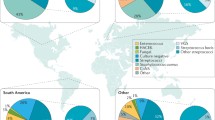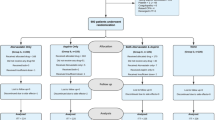Abstract
The role of inflammatory mechanisms in the initiation, progression and clinical expression of atherosclerosis is increasingly appreciated. With this awareness, the possibility that acute or chronic infection may initiate or modulate these processes is an active area of investigation.
Infectious organisms may influence the atherosclerotic process through direct local effects on the coronary endothelium, on vascular smooth muscle cells and on macrophages in the atherosclerotic lesion. Infection may also exert systemic effects by inducing the elaboration of cytokines, the creation of a hypercoagulable state and by activating monocytes, causing possible transmission of infectious material to atherosclerotic lesions. Macrophages may then elaborate multiple mediators which destabilise plaque, promoting rupture and progression.
Seroepidemiological data have identified associations between clinically active atherosclerosis and evidence of infection with Helicobacter pylori, Chlamydia pneumoniae and some herpesviridae. In addition, pathological examinations have demonstrated the presence of infectious organisms in coronary artery plaques. Cytomegalovirus, for example, has been identified pathologically to be associated with transplant vasculopathy and with an increased risk of restenosis following coronary intervention. Finally, recent pilot trials have demonstrated that macrolide antibacterial treatment directed against C. pneumoniae reduces the risk of recurrent coronary events.
Infectious organisms may therefore influence atherogenesis through multiple pathways, and pathological and seroepidemiological investigations provide evidence of this association. Future large-scale clinical trials are needed to further evaluate the evidence of causality and the efficacy of antibacterial therapy for coronary artery disease.
Similar content being viewed by others
References
Ophuls W. Arteriosclerosis and cardiovascular disease. JAMA 1921; 76: 700–1
Thorn DH, Grayston JT, Siscovick DS, et al. Association of prior infection with ChlamyJia pneumonia and angiographically demonstrated coronary artery disease. JAMA 1992; 268: 68–72
Fabricant CG, Fabricant J, Litrenta MM, et al. Virus-induced atherosclerosis. J Exp Med 1978; 148: 335–40
Libby P, Egan D, Skarlatos S. Role of infectious agents in atherosclerosis and restenosis: an assessment of the evidence and need for future research. Circulation 1997; 96: 4095–103
Cook PJ, Lip GYH. Infectious agents and atherosclerotic vascular disease. Q J Med 1996; 89: 727–35
Fuster V. Mechanisms leading to myocardial infarction: insights from studies of vascular biology [published erratum appears in Circulation 1995 Jan 1; 91 (1): 256]. Circulation 1994; 90: 2126–46
Fuster V. Human lesion studies. In: Numano F, Ross R, editors. Atherosclerosis IV: recent advances in atherosclerosis research. New York City: The New York Academy of Sciences, 1997: 207–25
Drexler H. Endothelial dysfunction: clinical implications. Prog Cardiovasc Dis 1997; 39: 287–324
Fuster V, Badimon L, Badimon JJ, et al. The pathogenesis of coronary artery disease and the acute coronary syndromes. N Engl J Med 1992; 326: 242–50
Fuster V, Badimon L, Badimon JJ, et al. The pathogenesis of coronary artery disease and the acute coronary syndromes. N Engl J Med 1992; 326: 310–8
Stary HC. Evolution and progression of atherosclerotic lesions in coronary arteries of children and young adults. Arteriosclerosis 1989; 99: I-19-32
Falk E, Shah PK, Fuster V Coronary plaque disruption. Circulation 1995; 92: 657–71
Ambrose JA, Tannenbaum M, Alexpoulos D, et al. Angiographic progression of coronary artery disease and the development of myocardial infarction. J Am Coll Cardiol 1988; 12: 56–62
Libby P. Atheroma: more than mush. Lancet 1996; 348: s4–7
Richardson PD, Davies MJ, Born GV Influence of plaque configuration and stress distribution on fissuring of coronary atherosclerotic plaques. Lancet 1989; II: 1462–3
Fuster V, Fallon JT, Nemerson Y Coronary thrombosis. Lancet 1996; 348: s7–10
Wang P, Ba ZF, Chaudry IH. Administration of tumor necrosis factor-α in vivo depresses endothelium-dependent relaxation. Am J Physiol 1994; 266: H2535–41
Bhagat K, Moss R, Collier J, et al. Endothelial ‘stunning’ following a brief exposure to endotoxin: a mechanism to link infection and infarction? Cardiovasc Res 1996; 32: 822–9
Hajjar DP, Pomerantz KB, Falcone DJ, et al. Herpes simplex virus infection in human arterial cells: implications in arteriosclerosis. J Clin Invest 1987; 80: 1317–21
Epstein SE, Speir E, Zhou YF, et al. The role of infection in restenosis and atherosclerosis: focus on cytomegalovirus. Lancet 1996; 348: s13–7
Ridker PM, Cushman M, Stampfer MJ, et al. Inflammation, aspirin, and the risk of cardiovascular disease in apparently healthy men. N Engl J Med 1997; 336: 973–9
Vallance P, Collier J, Bhagat K. Infection, inflammation, and infarction: does acute endothelial dysfunction provide a link? Lancet 1997; 349: 1391–2
Woordhouse PR, Khaw KT, Plummer M, et al. Seasonal variation of plasma fibrinogen and factor VII activity in the elderly: winter infections and death from cardiovascular disease. Lancet 1994; 343: 435–9
Sammalkorpi K, Valtonen V, Kerttula Y, et al. Changes in serum lipoprotein pattern induced by acute infections. Metabolism 1988; 37: 859–65
Melnick JL, Adam E, DeBakey ME. Possible role of cytomegalovirus in atherogenesis. JAMA 1990; 263: 2204–7
Grattan MT, Moreno-Cabral CE, Starnes VA, et al. Cytomegalovirus infection is associated with cardiac allograft rejection and atherosclerosis. JAMA 1989; 261: 3561–6
Lemstrom K, Sihvola R, Bruggeman C, et al. Cytomegalovirus infection-enhanced cardiac allograft vasculopathy is abolished by DHPG prophylaxis in the rat. Circulation 1997; 95: 2614–6
Zhou YF, Leon MB, Waclawiw MA, et al. Association between prior cytomegalovirus infection and the risk of restenosis after coronary atherectomy. N Engl J Med 1996; 335: 624–30
Guetta E, Guetta V, Shibutani T, et al. Monocytes harboring cytomegalovirus: interactions with endothelial cells, smooth muscle cells, and oxidized low-density lipoprotein. Circ Res 1997; 81: 8–16
Orenstein JM, Fox C, Wahl SM. Macrophages as a source of HIV during opportunistic infections. Science 1997; 276: 1857–61
Speir E, Modali R, Huang ES, et al. Potential role of human cytomegalovirus and p53 interaction in coronary restenosis. Science 1994; 265: 391–4
Mendall MA, Goggin PM, Molineaux N, et al. Relation of Helicobacter pylori and coronary heart disease. Br Heart J 1994; 71: 437–9
Patel P, Mendall MA, Carrington D, et al. Association of Helicobacter pylori and Chlamydia pneumoniae infections with coronary heart disease and cardiovascular risk factors. BMJ 1995; 311: 711–4
Wald NJ, Law MR, Morris JK, et al. Helicobacter pylori infection and mortality from ischaemic heart disease: negative result from a large, prospective study. BMJ 1997; 315: 1199–201
Niemela S, Karttunen T, Korhonen T, et al. Could Helicobacter pylori infection increase the risk of coronary heart disease by modifying serum lipid concentrations? Heart 1996; 75: 573–5
Whincup PH, Mendall MA, Perry IJ, et al. Prospective relations between Helicobacter pylori infection, coronary heart disease, and stroke in middle aged men. Heart 1996; 75: 568–72
Danesh J, Peto R. Risk factors for coronary heart disease and infection with Helicobacter pylori: meta-analysis of 18 studies. BMJ 1998; 316: 1130–2
Cook PJ, Honeybourne D. Chlamydia pneumoniae. J Anti-microb Chemother 1994; 34: 859–73
Campbell LA, O’Brien ER, Cappuccio AL, et al. Detection of Chlamydia pneumoniae TWAR in human coronary atherectomy tissues. J Infect Dis 1995; 172: 585–8
Muhlestein JB, Hammond EH, Carlquist JF, et al. Increased incidence of Chlamydia species within the coronary arteries of patients with symptomatic atherosclerotic versus other forms of cardiovascular disease. J Am Coll Cardiol 1996; 27: 1555–61
Ramirez JA, Chlamydia pneumoniae/Atherosclerosis study group. Isolation of Chlamydia pneumoniae from the coronary artery of a patient with coronary atherosclerosis. Ann Intern Med 1996; 125: 979–82
Fong IW, Chiu B, Viira E, et al. Rabbit model for Chlamydia pneumoniae infection. J Clin Microbiol 1997; 35: 48–52
Laitinen K, Laurila A, Pyhala L, et al. Chlamydia pneumoniae infection induces inflammatory changes in the aortas of rabbits. Infect Immun 1997; 65: 4832–5
Muhlestein JB, Anderson JL, Hammond EH, et al. Infection with Chlamydia pneumoniae accelerates the development of atherosclerosis and treatment with azithromycin prevents it in a rabbit model. Circulation 1998; 97: 633–6
Saikku P, Leinonen M, Mattila K, et al. Serological evidence of an association of a novel Chlamydia, TWAR, with chronic coronary artery disease and myocardial infarction. Lancet 1988; 2: 983–6
Saikku P, Leinonen M, Tenkanen L, et al. Chronic Chlamydia pneumoniae infection as a risk factor for coronary heart disease in the Helsinki Heart Study. Ann Intern Med 1992; 116: 273–8
Thorn DH, Wang SP, Grayston JT, et al. Chlamydia pneumoniae strain TWAR antibody and angiographically demonstrated coronary artery disease. Arterioscler Thromb 1991; 11: 547–51
Miettinen H, Lehto S, Saikku P, et al. Association of Chlamydia pneumoniae and acute coronary heart disease events in non-insulin dependent diabetic and non-diabetic subjects in Finland. Eur Heart J 1996; 17: 682–8
Gupta S, Leatham EW, Carrington D, et al. Elevated Chlamydia pneumoniae antibodies, cardiovascular events, and azithromycin in male survivors of myocardial infarction. Circulation 1997; 96: 404–7
Gurfinkel E, Bozovich G, Daroca A, et al. Randomized trial of roxithromycin in non-Q-wave coronary syndromes: ROXIS pilot study. Lancet 1997; 350: 404–7
Gurfinkel E, Bozovich G, Mejail I, et al. Roxithromycin in the Non-Q-Wave Coronary Events: final results of the ROXIS study at 6 months follow-up [abstract]. J Am Coll Cardiol 1998; 31: 451A
Petrinec D, Liao S, Holmer DR, et al. Doxycycline inhibition of aneurysmal degeneration in an elastase-induced rat model of abdominal aortic aneurysm: preservation of aortic elastin associated with suppressed production of 92kD gelatinase. J Vasc Surg 1996; 23: 336–46
Author information
Authors and Affiliations
Corresponding author
Rights and permissions
About this article
Cite this article
Schussheim, A.E., Fuster, V. Antibiotics for Myocardial Infarction?. Drugs 57, 283–291 (1999). https://doi.org/10.2165/00003495-199957030-00002
Published:
Issue Date:
DOI: https://doi.org/10.2165/00003495-199957030-00002




